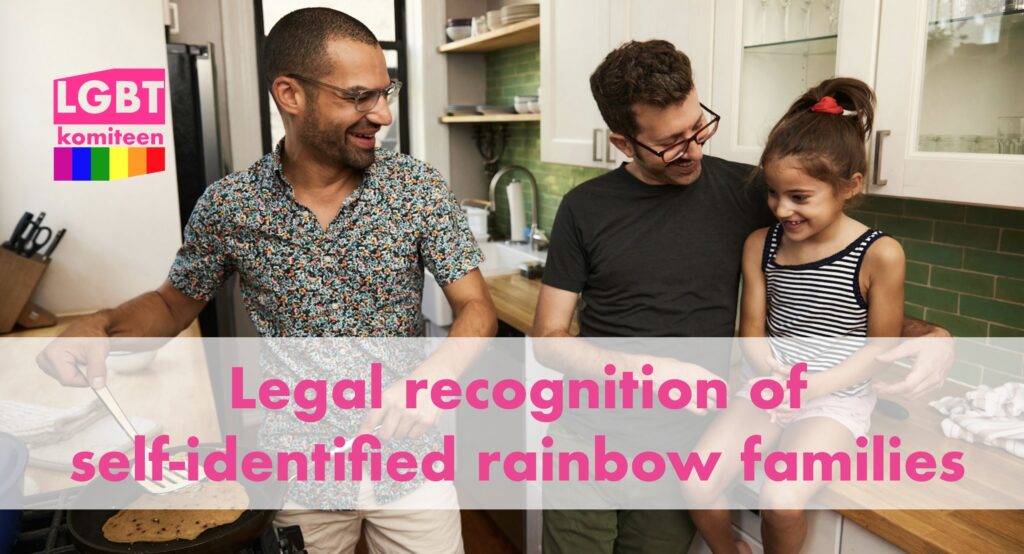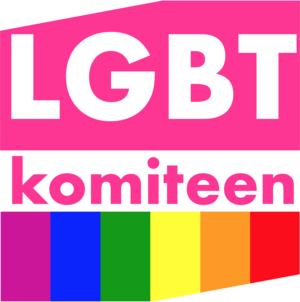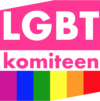
With the coming into force of the recent amendment to the Children’s Act Denmark now recognise rainbow families conceived by home-insemination, and there is no longer any need for second-parent adoption for children born in rainbow families in Denmark. Furthermore, trans persons becoming parents are recognised in their proper gender. Thus, e.g., a trans man giving birth to a child will be recognised as the father of the child.
The amendment has been a long time in the making. It was passed by a massive majority of the Danish Parliament, Folketinget, but its implementation was hampered by a tedious discussion on a possible conflict with the EU Tissues and Cells Directive. It finally came into force September 2nd.
The new additions to the law
Generally speaking the amendment constitutes two new additions to Danish family law: 1) recognition of home-insemination, and 2) recognition of trans parenthood.
Home-insemination
Since 2013 rainbow families are covered by the Children’s Act. This means, that the parents in rainbow families are recognised after the provisions of the Children’s Act as any other parents. Previously, rainbow parents had to rely on second-parent adoption.
The law recognises three parties: the person giving birth to the child (the mother), said persons possible female partner (the co-mother) and the person providing the sperm (either the sperm donor or the father). The terms in brackets are the roles defined in the Children’s Act. Before conceiving the child, the parties settle their roles by means of declarations and statements of consent: the mother-to-be acknowledge the attempt of conceiving and will become legal parent to a resulting child. The three parties must decide, if the second legal role should be a co-mother or a father. If they go for the co-mother, the co-mother-to-be must sign a declaration of consent that her partner is treated. Also, the three parties sign a maternity statement that the partner of the mother-to-be is to be considered legal parent, i.e., co-mother, whereas the sperm provider is to be considered a sperm donor. If, on the other hand, they go for the father, the partner of the mother-to-be must again sign a declaration of consent, that the attempt to conceive takes place, and the sperm-provider must sign a paternity statement that he is to be considered legal parent.
With these declarations it is settled, who are to be legal parents of the child once it is born. Consequently, the registration of parenthood is then a simple administrative procedure after the birth. It was important for us that the rights of all parties are protected. Thus, even if the mother is married to a woman, the agreement can still be, that the man is considered the legal parent.
Evidently, the declarations are binding. There has been a case, where a co-mother-to-be wanted to evade the agreement before the child was born. The case went to the supreme court, and the decision was clear: the declarations are binding. This is also how we anticipated and designed the legislation originally: the basic principle is, that if you engage in conceiving a child, you are responsible. That also holds under the rules regarding rainbow families.
However, these provisions were only applicable when the child was conceived in a fertility clinic. We wanted to get rid of this pathologisation of procreation in rainbow families. With the current amendments this restriction is lifted, and the provisions are also applicable in the case of home-insemination, i.e., where the child is conceived privately. The declarations are then sent to the Agency of Family Law (Familieretshuset). If, after the birth, a disagreement arise between the parties the declarations will define the legal parents. When the child is born the parents can register like everyone else by a simple administrative procedure.
From a legal point of view there is no difference between conceiving by means of home-insemination or by means of an intercourse: it is something that takes place in private without the involvement of any authorities.
With these amendments all rainbow children born in Denmark can get their parents recognised by means of the Children’s Act. Thus, 25 years after we got access to second-parent adoption we can leave that behind, which is highly appreciated as adoption comes with some restrictive rules which have caused much pain over the years.
As explained, the law only recognises three parties: the mother, the co-mother, and the sperm donor/the father. The partner of the sperm provider has no role. We have been calling for recognition of multiple legal parents, but for the time being, a child can have only two legal parents. Also, for the time being, pregnancy donation (surrocacy) is not recognised in Denmark, and consequently the person giving birth is always recognised as a legal parent. Thus there is only one free position, which according to our legislation can be either a co-mother or a father.
Trans parents
In spite of the wording of the law being as indicated above, i.e., mother, co-mother, and father, the current amendment also provides for recognition of trans parents.
In 2013 Denmark introduced self-determination of legal gender. Previously, a trans person had to have gender-affirming surgery before being able to change the gender in the person registry. Now, however, it is a simple procedure where you simply file your request to the registry. Other parts of the legislation were not changed at the same time, though, but most legislation is written in a gender neutral form. This is not the case, though, for the Children’s Act.
There is no willingness to rewrite the entire Children’s Act. Instead, the current amendment introduces provisions saying that trans persons are recognised as parents according to their legal gender with rights and responsibilities according to the gender before reassignment. Thus, for instance, a trans man giving birth is recognised as a father, but he will, for instance, get parental leave as a mother, i.e., e.g., four weeks before the expected time of birth.
Implementation: troubles with EU directive
The bill was passed by a large majority of the Parliament: 95 votes in favour, 10 against. Only the far right voted against the bill. This was in February 2022. The amendments were supposed to come into force later that year. However, the Ministry of Health blocked the procedure as they were in doubt if the amendments conflicted with the EU Tissues and Cells Directive: should a sperm donor, who donates sperm privately, be considered a tissue establishment in the sense of the Tissues and Cells Directive? After many efforts and even a decision from High Court the ministry gave up their reluctance in December 2023 and accepted the coming into force of the amendment.
With the current amendments rainbow families can now self-identify without consulting any authorities. Also they have the remedies to settle conflicts, which may arise.
The historical development
1989 Registered partnership
As the first country in the world Denmark introduced the registered partnership in 1989. The legislations was very simple: registered partnership was defined as having the same legal implications as marriage except provisions on requirements regarding citizenship of the partners, possibility of church wedding, and everything related to parenting.
1999 Second-parent adoption
In the following years we fought against these restrictions and were successful in relation to parenting: in 1999 Denmark became the first country to enable a child to have same-sex parents. This was by means of second-parent adoption within a registered partnership.
However, under the adoption regime a number of rules followed. 1) A child could not be adopted before at least 3 month after the birth, and 2) the adoptee had to be at least 25 years old. 3) The parents and child (!) should have lived together for at least 2.5 years. In 2009 the rules were annulled for same-sex couples in case of assisted reproduction in a fertility clinic. The rules still applied for home insemination.
[Rainbow families 2008, analysis of the situation of rainbow families in Denmark][Note from EuroLetter, 2009]
[Lesbian and foreigner, article from ILGA-Europe’s Destination Equality magazine theme issue on double discrimination, winter 2011-12]
2002 Major revision of the Children’s Act
Though the Children’s Act of 2002 did not apply to rainbow families it had an important impact. Previously, only women could start a paternity case. Unfortunately we had many cases where a lesbian couple and a gay man had decided to make a family, but when the child was born, the man was pushed aside and did not become part of the family. The 2002 revision created the option for a man to start a paternity case, thus giving a man remedies to protect his parenthood.
2013 Children’s Act
In 2012 I made a presentation in a hearing arranged by the Parliament. Here I presented a proposal on an inclusive Children’s Act coping with rainbow families. The Government wanted to include rainbow families under the Children’s Act, but its subsequent solution was highly unsatisfying: they suggested a model, where a woman married to a woman who gave birth to a child, should automatically be recognised as legal parent. We succeeded to sink this unacceptable proposal and instead we got a model, which I presented at the hearing: a model where three parties agree with each other who should be the two legal parents. The one giving birth was automatically recognised, whereas either the female partner or the person providing the sperm would be recognised as the other legal parent. Rules applied to married as well as unmarried parties.
The rainbow family provisions of the 2013 Children’s Act only applied to children conceived in a fertility clinic, though. The reason for this restriction was, that the politicians wanted to ensure, that the parents-to-be understood the consequences of the legislation. They thought the clinics could provide such counselling (which they in fact were utterly incapable of). Also, the clinics would receive the declarations required by law (but they never knew what to do with them). If a child was not conceived in a fertility clinic, but for instance by means of home-insemination, the provisions of the Children’s Act did not apply. In such cases the families had to rely on second-parent adoption (for co-motherhood) or the common rules of the Children’s Act (for fatherhood).
[Slides with notes from presentation of the law at ILGA-Europe annual conference 2013]2024 Children’s Act: home-insemination
When in 2021 the Government drafted the bill of the current amendments they again suggested that a wife of a woman giving birth should automatically be recognised as legal parent, and once again we had to get this unacceptable provision out of the bill. We succeeded and instead it is the 2013 model that apply. The bill was passed in February 2022 with 95 votes in favour and 10 votes against. Only the far right voted against.
Subsequently, however, the coming into force of the law was blocked by the Ministry of Health. They were of the opinion that a person donating sperm privately might be considered a tissue establishment in the sense of the EU Tissues and Cells Directive. We argued that there is no legal distinction between home-insemination and intercourse and evidently the EU does not sanction the latter. Also, a sperm doner at home-insemination is not comparable to a sperm-donor in the fertility industry. The latter delivers a product, which is to be handled by third parties under strict regulation for the sake of patients and workers safety in the health sector. The department didn’t agree. A decision from the Western High Court came to the same conclusion as we did, that home-insemination is not violating the regulation in the Tissues and Cells Directive. Yet, the department still didn’t react. Then we activated the Parliament, which posed questions at the minister, who then finally agreed and dropped the blocking af the law.
In the process of bringing the law into force official guidelines are written. These were also subject to a public hearing, where we succeeded in getting rid of some unsatisfying language, e.g., the use of the term birth gender (in Danish: fødselskøn), which is not a term in the law text.
[On the passing of the bill, 2022][Compendium of inclusive family law, review and proposals, 2021]
Future
The Government has made an agreement with almost all parties outside the Government about pregnancy donation (surrogacy). With the agreement it will become easier for the Danish authorities to recognise parenthood of Danish parents using surrogacy either abroad or in Denmark. It will no longer require second-parent adoption. The main criterion will be that the child has to benefit from the recognition. The agreement will come into force January 1st 2025.
[Agreement on surrogacy (in Danish)]Also, the Government are planning to extend som legal consequences of parenthood to more than two persons, not recognising more than two legal parents, though. We reject the proposal.
[Comments on the policy (in Danish)]We keep calling for recognition of more than two parents. We have formulated a specific model for that.
[Associate parenthood – a proposal]The references above are texts in English. You can find endless amounts of documentation in Danish on Panbloggen (until 2019) and LGBT komiteen (since 2019)

